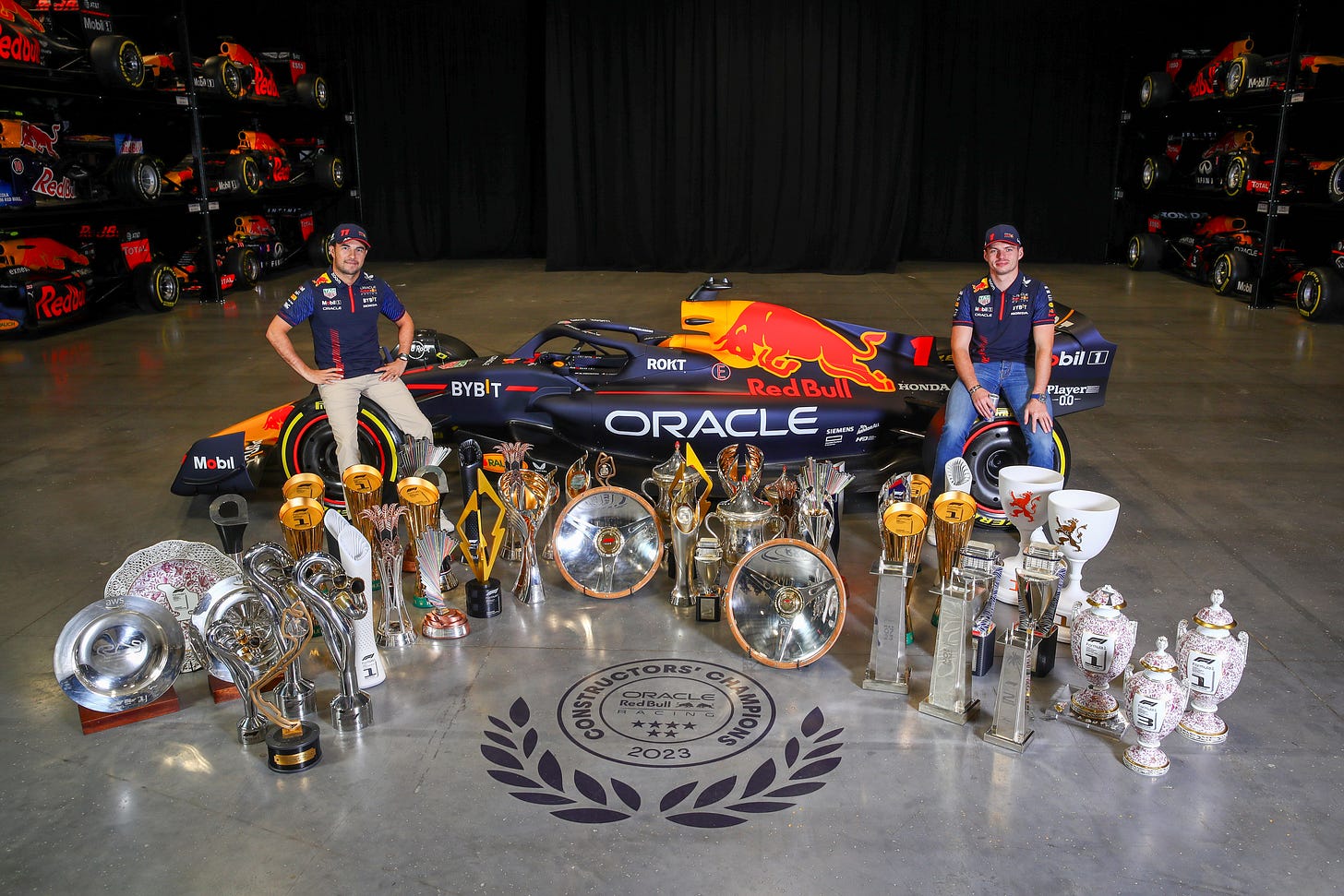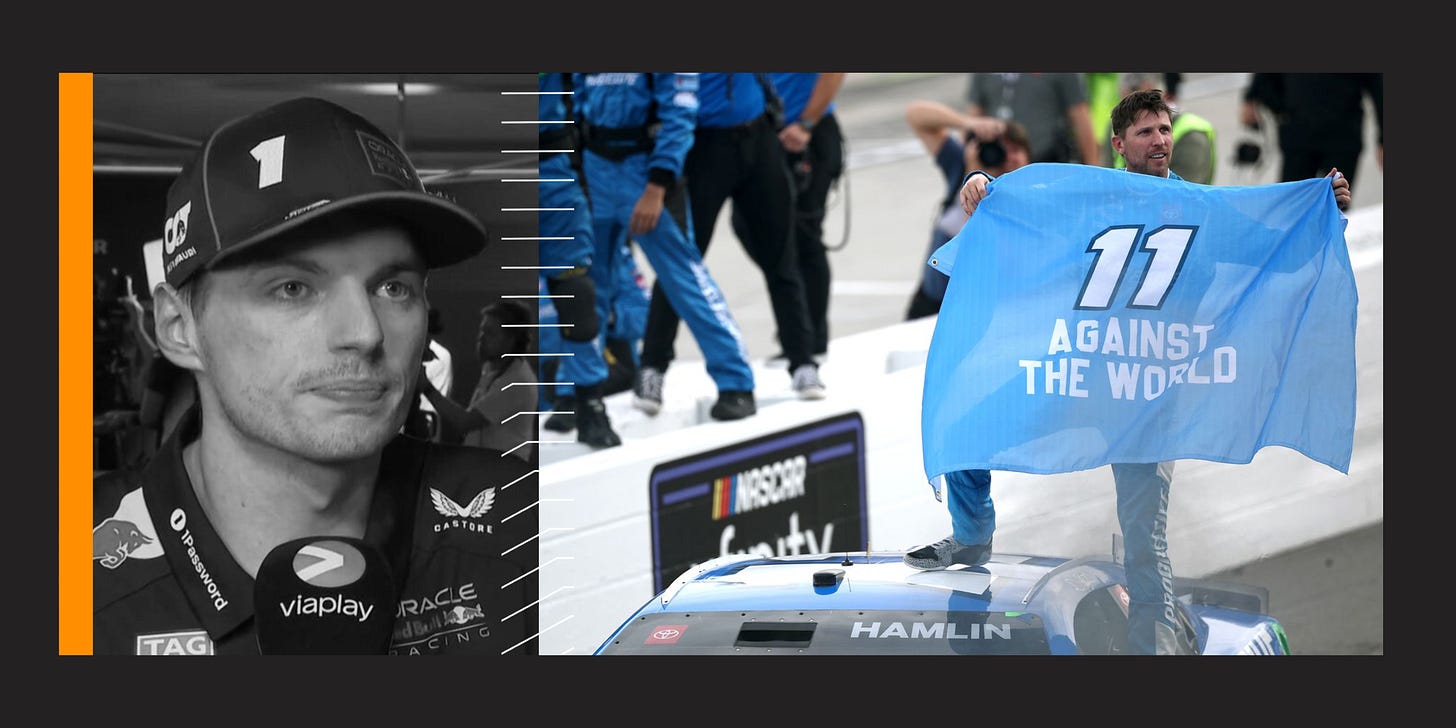Checkered Reputations: Part One - Hamlin stirs NASCAR’s storm with unapologetic flair
In this series, The Asterisk explores how drivers like Denny Hamlin and Max Verstappen fuel fan engagement with their defiant spark.
“Really?” the commentator watched in disbelief.
“He was headed in such a good direction,” chuckled the colour analyst.
“Everybody liked him this time,” he added, as boos began to drown out the cheers at Martinsville Speedway in Virginia.
Joe Gibbs Racing’s Denny Hamlin had not only clinched the NASCAR Cup Series race in dominant fashion on March 30, he also hit a nerve.
Following his emphatic win, the veteran driver decided to have one last laugh.
Hamlin stood on top of his blue No. 11 Toyota Camry XSE, raised his fist to the crowd, and then unfurled a flag that read “11 AGAINST THE WORLD.”
The gimmick turned swathes of the crowd at the historic paperclip-shaped track during the post-race interview, and Hamlin relished it.
Who is Denny Hamlin?
Hamlin competes in the NASCAR Cup Series (NCS) for Joe Gibbs Racing. He has racked up 56 NCS victories in his 20-year career as a professional stock car racing driver and holds the record for the most wins in the series without a championship.
The 44-year-old also co-owns 23XI Racing with basketball legend Michael Jordan, which competes in the same series.
The three-time Daytona 500 winner is no stranger to controversy and is also known for trash-talking.
“Why not?” was Hamlin’s blunt response when asked why he would want to add to his troubles with his gimmick at Martinsville.
“That’s me,” he laughed. “If I can’t trash talk, then it takes away my superpower. It really does.”
“I’m not nearly as good. My friends, it drives them absolutely crazy, but to me, that part of it fuels me, and it just makes me feel good.”
The villain of NASCAR
Hamlin’s antics have earned him the title of the villain in America’s most-watched motorsports series.
The veteran admitted to his role in the archetype and how it motivates him to perform better.
“Certainly, it just kind of took on a life of its own, and I definitely had my part in it,” he told NASCAR Daily. “I understand that I play into it.”
“A lot of it comes from the banter I usually have day-to-day with friends, family, and everyone.”
“When the fans started booing and whatnot a few years ago, I was like, ‘Alright, if you want to do that, then I’m going to show you,’ and it just fuelled me more to want to be the guy that beats your favourite driver.”
Starring in Netflix
Anyone who loves motorsport has heard that last line. It is even highlighted in the trailer for NASCAR: Full Speed, a Netflix docu-series released in 2024.
The show is modelled after Drive to Survive, a docu-series on Formula One that led to an explosion of new and younger fans.
NASCAR: Full Speed follows a cast of nine drivers throughout the 2023 season, and Hamlin stands out.
The stakes, the glory, and his unapologetic approach cast Hamlin as a strategic antagonist. These three characteristics have also shaped four-time Formula One champion and Red Bull Racing driver Max Verstappen as a cold-blooded competitor and stoic executioner who isn’t there to be liked or entertain, just to win. In essence, the duo are lightning rods in their respective categories, keeping fans engaged beyond the tarmac.
Hamlin leans into the villain archetype, whereas Verstappen has no interest in playing to the camera. The Dutchman’s driving does all the talking. His collision with Sir Lewis Hamilton at Turn 2 of the 2021 Italian Grand Prix was louder than any soundbite.
The characteristics that Hamlin and Verstappen embody, viewed as 'villainous' by fans, make them prime targets for those eager to see them fail or be defeated.
Hero-villain narrative the crux of sport
The Asterisk interacted with Dr. Mark Howell, a motorsport expert and historian, to understand how Hamlin fits into the sport’s tradition of larger-than-life characters and what makes Verstappen distinct.
“Civilization has always recognised the dichotomy between good and evil,” Dr. Howell begins. “Throughout history, the hero/villain narrative has been at the crux of our sacred and secular traditions. Most professional sports, I believe, also lean toward a hero/villain or good/bad structure."
“In major league baseball, it's the Boston Red Sox versus the New York Yankees. In professional football, it used to be the Dallas Cowboys versus the Pittsburgh Steelers.
“It's no different in NASCAR, especially within the Cup Series which is NASCAR's most recognised and most visible division,” says the professor of Communications at Northwestern Michigan College.
Within that ecosystem, Denny Hamlin has assumed the "bad guy" reputation once held by the late Dale Earnhardt, according to Dr. Howell. The expert, however, referred to Hamlin as the lesser of these two "evils," given his lower number of career wins and his lack of NCS titles.
The Joe Gibbs Racing driver is not the only bad boy of the series; others exist. One, Ross Chastain, knows how to ride the wall, while Hamlin knows how to break the fourth wall.
“Ross Chastain has been lionised as another NCS 'villain' for his overly aggressive driving,” adds Dr. Howell. “But it's the outspoken media savvy of Hamlin that's earned him the moniker.”
“It’s important to remember that NASCAR was established on the premise that fans would eagerly pay to watch moonshiners race each other in showroom stock automobiles,” says the expert, who has published books on the historical and cultural significance of NASCAR.
Those races would have made for a spectacle. Dr. Howell also reveals that cars were often secretly modified during that time.
“In the first official NASCAR Strictly Stock event at the Charlotte Fairgrounds in 1949, the winner was disqualified for tampering with his car's rear springs,” he points out as an interesting fact.
Popular for the wrong reasons? It’s in the DNA
America’s most popular race car driver is also an aggressive, win-at-all-costs speedster, much like Verstappen.
A 2018 YouGov survey found legendary NASCAR driver Dale Earnhardt to be the most popular race car driver in the US.
Nicknamed ‘The Intimidator,’ Earnhardt bumped, blocked, and battled his way to the front, winning seven NASCAR Cup Series championships during his career.
While Earnhardt often found himself in a ‘driver vs. driver’ conflict, Hamlin squarely falls under the ‘driver vs. organisation’ type.
“During Dale Earnhardt's time, 'The Intimidator' was often paired against such 'good guys' as Jeff Gordon or Bill Elliott,” recalls Dr. Howell, adding that while Earnhardt and Gordon were rivals on track, they were business partners who shared profits from each other’s merchandise sales off it.
“Hamlin, on the other hand, seems to be matched against NASCAR as a whole, heading up the Race Drivers Alliance and suing the sanctioning body for its somewhat draconian team charter rules.”
The 44-year-old veteran, along with 23XI Racing and Front Row Motorsports, filed a lawsuit last year alleging that NASCAR’s rules are monopolistic and restrict fair competition, impacting the profitability and autonomy of racing teams.
“Hamlin is a competitive driver, but his villainy often seems focused on the larger organisational picture. Questionable officiating, administrative decision-making, amorphous rule changes, and evolving technical details are more likely to get a rise out of Hamlin than his need to shove another car into the retaining wall.”
‘Hamlin not really a villain’
Dr. Howell believes that Hamlin doesn't truly fit the typical villain archetype.
“In the absence of an 'Intimidator' like Earnhardt, and given the closely scrutinised on-track behaviour of a Ross Chastain, Hamlin presents himself more as an aggrieved elder statesman than a dyed-in-the-wool villain,” he explains.
“Whereas a villainous driver might hit a competitor and 'accidentally' do them harm,” he says, referring to Austin Dillon's last-lap spin of Aric Almirola to win the 2018 Daytona 500.
Although Hamlin has leaned into his villainous persona, Dr. Howell argues that the driver is a clean racer and seems more content being a NASCAR critic.
“He'll race his NCS competition as cleanly as conditions allow, then turn to the internet to voice his anger and argue publicly about the sanctioning body's legislative behaviour, such as NASCAR's delay in levelling penalties against aggressive drivers at the XFINITY debacle at Martinsville.”
Formula One fans may have wished their bad boy drove in the same manner as Hamlin. However, the Red Bull driver’s racecraft is unironically intriguing.
The media’s portrayal of Verstappen and Hamlin in the 'villain archetype' sits squarely in the intersection of their Venn diagram.
But what makes their personas so effective in driving the narrative and spectacle of their respective sports?
Rooting for anti-incumbency
Dominance draws hate. Maybe that’s too strong a feeling, but no one likes watching the same team win over and over. Dr. Howell drives this point home with his analysis.
“Sports fans frown upon dominance, unless it's exhibited by their favourite team/driver,” he explains. “Notice the backlash against the Kansas City Chiefs in the NFL; the Philadelphia Eagles enjoyed a larger-than-normal fanbase during Super Bowl LIX, thanks to a vocal contingent of anybody-but-the-Chiefs supporters. The same thing exists in NASCAR.”
“Whenever a driver dominates a season (Richard Petty, Dale Earnhardt, Bill Elliott, Jeff Gordon, Jimmie Johnson, and Kyle Busch, to name a few), there’s an immediate anti-‘insert driver’s name’ response."
“I travelled the NCS circuit during the 'Anybody But Earnhardt' and 'Anybody But Gordon' eras, times when you'd see signs like these hanging from campers in the infield. Dominance breeds vocal critics. This mode of criticism is what we're seeing with Denny Hamlin and Max Verstappen,” says Dr. Howell who was a part-time crew member with Brett Bodine Racing in the Monster Energy NCS.
Although Lewis Hamilton enjoyed a longer period of dominance, he didn’t crush his competition the way Verstappen has. The Dutchman was more of a juggernaut.

Verstappen made winning with Red Bull feel like sipping The Macallan 1926, smooth and refined. The Dutchman has racked up 54 Grand Prix wins in 94 races since his championship-winning streak began in 2021.
“In Verstappen's case, the criticism is obvious given his phenomenal streak of F1 wins and championships,” says Dr. Howell, noting that similar reactions have occurred with Ayrton Senna, Michael Schumacher, and Lewis Hamilton over the years.
“Consistent wins are only good for the athlete and their fans,” he points out. “Denny Hamlin asserts himself and becomes a playoff contender, but not through sheer dominance like we've seen from Max.”
Hamlin’s fiery taunts and Verstappen’s metronomic charge inject drama into every lap. Often booed, these polarising characters captivate fans by splitting cheers and jeers. As Hamlin vies for NASCAR’s elusive crown, will he seize glory, or remain its boldest voice?
Stay tuned for Part Two: Verstappen’s ruthless pursuit keeps fans engaged.





